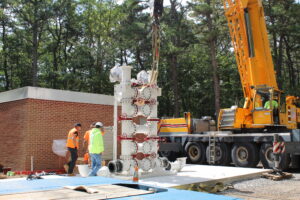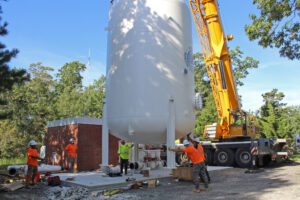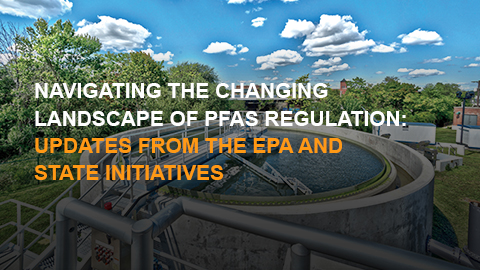Case Study: Swift PFAS Removal for Atlantic City Municipal Utilities Authority
The Challenge

New Jersey was one of the first states to begin regulating per- and polyfluoroalkyl substances (PFAS), a group of man-made chemicals that include PFOA, PFOS, and many others. As early as 2019, regulations concerning PFNA were implemented. Subsequently, when the State set PFAS maximum contaminant limits (MCLs) for PFOS and PFOA, with sampling beginning in the first quarter of 2021, New Jersey water suppliers were tasked with bringing their water into compliance by the end of that year.
More recently, on March 14, 2023, the United States Environmental Protection Agency (EPA) announced a proposed National Primary Drinking Water Regulation (NPDWR) for six PFAS including perfluorooctanoic acid (PFOA), perfluorooctane sufonic acid (PFOS), perfluorononanoic acid (PFNA), hexafluoropropylene oxide dimer acid (HFPO-DA, commonly known as GenX Chemicals), perfluorohexane sulfonic acid (PFHxS), and perfluorobutane sulfonic acid (PFBS). While this proposed regulation does not require any action until it is finalized and passed, it is anticipated that this will be finalized by the end of 2023. Additional compounds are likely to be regulated in the near term as well.
A regulation of this magnitude will make a significant impact on the water supply when it is fully implemented. As health authorities continue to manage regulations that are protective of public health, the challenge for water purveyors will continue to be in management and execution, ensuring appropriate investments and treatment systems are implemented in accordance with the aggressive timelines being promulgated.
H2M recently won Honor Awards from the American Council of Engineering Companies (ACEC) in both New York and New Jersey for its swift work addressing new PFAS regulations in Atlantic City which could have rendered the city non-compliant and required rapid design and deployment of an emergency PFAS treatment system.
The Project

The Atlantic City Municipal Utilities Authority (ACMUA), like many other utility providers, was challenged by these new regulations. Atlantic City has two sources for their water supply: surface water and groundwater. The established wells in this municipality are along a lake bordering the Atlantic City International Airport. Due to years of contamination from the foam used in firefighting drills held at the airport, PFAS levels in the water supply were high and required emergency action to achieve MCL compliance within the tight deadlines.
In New Jersey, compliance is currently calculated from the average of quarterly samples taken at the point of entry into the water distribution system. At the ACMUA site, the first quarter sample already exceeded the MCL. The team had to collaborate on creative solutions to ensure the PFAS levels in subsequent samples were low enough to mathematically compensate for the first quarter and bring the final average below the MCL. Failure to bring the average under the MCL would have resulted in multiple issues for the client, including Federal oversight and fines.
H2M’s Solution

The ACMUA tasked H2M with rapidly designing and deploying an emergency PFAS treatment plan to achieve regulatory compliance. The design team proposed installation of three sets of granular activated carbon (GAC) vessels, with one vessel pair at each well. Placement of the vessels on road plates avoided excessive soil disturbance and will enable easy removal when a permanent solution is introduced in the future. The design also included pumping modifications, such as new, higher horsepower and output pressure components to avoid the risk of downstream pressure loss from the addition of GAC vessels.
H2M also assisted with the permitting process and served in a consulting role on this project. Prior to officially being brought on board, H2M offered two recommendations to the client: 1) Since testing and analysis showed particularly high PFAS levels in the surface water supply, the firm recommended the utility should rely on groundwater alone to meet the needs of the municipality; and 2) the utility should immediately replace the GAC media already present in the treatment plant’s five gravity filter beds. Implementation of these recommendations brough the second quarter samples into compliance, but not the yearly average. Installation of the GAC vessels during the third and fourth quarters lowered PFAS concentration even further, bringing the overall average into compliance. The newly installed vessels now serve as the first line of defense against PFAS and will extend the lifespan of the GAC media in the treatment plant.
Avoiding imposing undue financial burdens on the community was an important element of this project. The project team created multiple models based on water quality data to determine which three wells would see the greatest improvement with intervention. The goal was to give the client the biggest bang for their buck. Further, due to pandemic-related supply chain issues and affiliated delays, the design plan underwent slight modifications. The GAC vessels were purchased before the design contract was completed and before contractors were selected. H2M facilitated this expedited process between ACMUA and Tigg, the vessel manufacturer. The road plates specified in the original design were replaced by concrete mats, resulting in a financial credit to the ACMUA and making up for some of the time lost due to supply chain challenges.
The evolving landscape of environmental and public health regulations require flexible, adaptable, cost-effective solutions with short turnaround times. When hazardous PFAS chemicals threatened the Atlantic City drinking water supply, H2M played multiple roles and leveraged the previous contamination treatment expertise to help.
H2M collected data and ran several analyses of the City’s water supply system and recommended the client cease its use of local surface water as part of the drinking water supply. The firm also identified three groundwater wells where an intervention could have the greatest impact on water supply. Throughout the design phase, H2M engaged the client’s in-house engineering team and the New Jersey Department of Environmental Protection (NJ DEP) to ensure the first design would meet the City’s needs and be approved. H2M leveraged innovative rapid deployment techniques that emphasize teamwork, rapid turnaround times, and modular solutions. During construction, the team faced the added complexity of a short timeframe due to New Jersey’s new PFAS compliance requirements.
This project’s success in reducing PFAS concentrations to state-approved levels showcases H2M’s ability to work under short deadlines, work in challenging situations, and proactively respond to issues, even before Federal regulations made national headlines. On top of that, its success also offers secondary social and economic benefits to the community in the form of mitigating environmental justice issues without overtaxing a low-income demographic.



